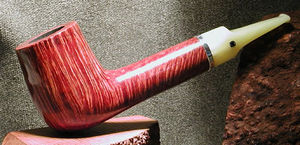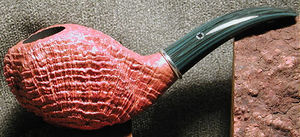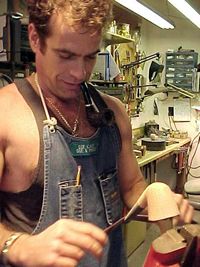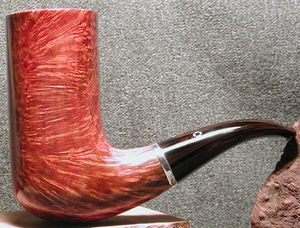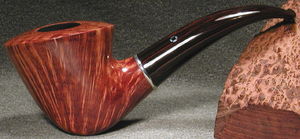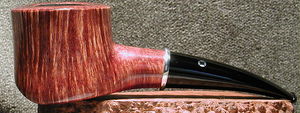Roush: Difference between revisions
(New page: Larry's [http://www.roushpipes.com/ website] Bellow-- Height: 3.600; Chamber: .900 Tapered; Length: 4.900; Diameter: 1.600; Shank Diameter: .780 Image:larryroush1.jpg Bellow-- Heigh...) |
No edit summary |
||
| Line 1: | Line 1: | ||
Larry's | [[Image:larryroush2.jpg|left|thumb|Height: 2.250; Chamber: .800; Length: 6.000; Diameter: 1.760; Shank Diameter: .800]] | ||
'''Larry's description:''' This Lovat is a Gp 6 to ODA sized piece and the Bakelite really sets it off. I do not make many like this and they are quite rare to say the least. The beauty of this piece is truly in the grain and I can’t take credit for that, I am just happy it turned out so nice and I didn’t drop it or something! I always get nervous working on a piece of this caliber. Hand cut Bakelite mouthpiece w/Delrin tennon, solid sterling fitment. | |||
[[Image:larryroush3.jpg|left|thumb|Height: 2.000; Chamber: .720; Length: 5.400; Diameter: 1.56X2.2; Shank Diameter: .600]] | |||
'''Larry's description:''' Not sure what got into me but I really love this piece and I really enjoy making this type of freehand. I have only made a handful of these pieces in the past but I hope to do more in the future. This piece is based on my bent Cutty design. I took that template to lay out the pipe and just let nature take its course. This piece came out with a awesome blast as you may be able to see in the photos. It is a wax only finish and with smoking and handling it colors up beautifully. Bella Cera means beautiful wax in Italian. The natural finish with the Emerald Ebonite looks great. This new Ebonite is quite different and I do believe it will be quite an asset to my line of pipes. It is from the same manufacturer of the rest of my Ebonite just a different color. This material along with the black has swirls of bluish-green. Hand cut Ebonite mouthpiece w/Delrin tennon. Graded L3 | |||
'''From Larry's website:''' | '''From Larry's website:''' | ||
[[Image:Larry Roush.jpg|left]] | |||
[[Image:larryroush1.jpg|right|thumb|Height: 3.600; Chamber: .900 Tapered; Length: 4.900; Diameter: 1.600; Shank Diameter: .780]] | |||
The following words are those of a pipe maker of course, but in essence they are those of an artist - myself. I think most pipe makers view themselves as artists akin to those who sculpt in stone or wood, but confining their work to a single subject: pipes. | The following words are those of a pipe maker of course, but in essence they are those of an artist - myself. I think most pipe makers view themselves as artists akin to those who sculpt in stone or wood, but confining their work to a single subject: pipes. | ||
For myself, what I'm interested in, and what I think other skilled pipe maker are interested in, is quality wood. The reason is quite simple - I am searching for the two primary qualities in a pipe: beauty and smokability. My primary source for Briar at the present time is Italy, and I am very pleased with its esthetic value and smoking qualities. Of course different wood from different growing areas appear different insomuch as grain is concerned. Regardless of the source, when briar is aged and air cured properly the smoking qualities will be the same. | For myself, what I'm interested in, and what I think other skilled pipe maker are interested in, is quality wood. The reason is quite simple - I am searching for the two primary qualities in a pipe: beauty and smokability. My primary source for Briar at the present time is Italy, and I am very pleased with its esthetic value and smoking qualities. Of course different wood from different growing areas appear different insomuch as grain is concerned. Regardless of the source, when briar is aged and air cured properly the smoking qualities will be the same. | ||
Every pipe maker sets his own standards and I have to look at the piece of briar to determine whether it will be a smooth pipe or not. Just because it is clean (without pits) doesn't mean it will become a smooth ROUSH. For a carved pipe, I select a block that will support the size pipe I want to make, position the template and draw the outline. In contrast, the crafting of a smooth pipe is unique in character and requires a substantial amount of time. Grain is a primary consideration, and the point beyond shape is where the eye of the artist is critical. I don't tell the briar block what I want, the block tells me. It's the grain that determines the shape not the template. I have always done all my own Gold and Silver work and use only solid Silver and 14k Gold. I really like the Combination of wood with silver and gold. I think it gives a very unique touch. Sometimes I use fossilized Walrus tusk or Mammoth tusk for inlays. This comes predominantly from Alaska and is found as a by-product of mining operations there. | Every pipe maker sets his own standards and I have to look at the piece of briar to determine whether it will be a smooth pipe or not. Just because it is clean (without pits) doesn't mean it will become a smooth '''ROUSH'''. For a carved pipe, I select a block that will support the size pipe I want to make, position the template and draw the outline. In contrast, the crafting of a smooth pipe is unique in character and requires a substantial amount of time. Grain is a primary consideration, and the point beyond shape is where the eye of the artist is critical. I don't tell the briar block what I want, the block tells me. It's the grain that determines the shape not the template. I have always done all my own Gold and Silver work and use only solid Silver and 14k Gold. I really like the Combination of wood with silver and gold. I think it gives a very unique touch. Sometimes I use fossilized Walrus tusk or Mammoth tusk for inlays. This comes predominantly from Alaska and is found as a by-product of mining operations there. | ||
[[Image:Larry Roush Pipe01.jpg|left|thumb]] | |||
I have always been demanding when it came to the pipes I smoked personally. As a result it took many years to perfect my finishing, curing, and carving techniques. I keep that in mind when I make a piece. If the finished pipe is not one I would keep for myself then it is just not good enough for sale. Being my own worst critic, not wanting to settle for less, has always been the most difficult part of pipe making. | I have always been demanding when it came to the pipes I smoked personally. As a result it took many years to perfect my finishing, curing, and carving techniques. I keep that in mind when I make a piece. If the finished pipe is not one I would keep for myself then it is just not good enough for sale. Being my own worst critic, not wanting to settle for less, has always been the most difficult part of pipe making. | ||
[[Image:Larry Roush Pipe02.jpg|right|thumb]] | |||
As a pipe maker I make every effort to turn out a quality pipe, regardless of shape or finish. This often involves painstaking and meticulous work, unknown to the buyer, but incorporates features that make the ROUSH pipes what they are today. [[Mike Butera]] and I once had a discussion on this very topic and determined that these many things we do relating to fit and finish, and attention to detail are simply the standards we set to make quality pipes. To short cut or deviate from these standard would not only be cheating the smoker and collector, but cheating ourselves. On a personal note, I feel fortunate to have this gift, this ability to see deeper than the surface of a fine piece of briar and respond by creating pipes that are shared and appreciated by others. I'm eternally grateful for three things: the insight to recognize in myself a talent and the courage to develop it; secondly, for the assistance and direction of Mike Butera, and third for the opportunity to take an idea, a simple thought, and turn it into something beautiful and useful. It is my hope and wish that you enjoy smoking and owning my pipes every bit as much as I enjoy making them. | |||
'''Larry Roush''' | |||
'''Contact information:''' E-mail: mailto:larry@roushpipes.com | '''Contact information:''' E-mail: mailto:larry@roushpipes.com | ||
Larry's website: [http://www.roushpipes.com/ Roush] | |||
Revision as of 20:45, 1 August 2007
Larry's description: This Lovat is a Gp 6 to ODA sized piece and the Bakelite really sets it off. I do not make many like this and they are quite rare to say the least. The beauty of this piece is truly in the grain and I can’t take credit for that, I am just happy it turned out so nice and I didn’t drop it or something! I always get nervous working on a piece of this caliber. Hand cut Bakelite mouthpiece w/Delrin tennon, solid sterling fitment.
Larry's description: Not sure what got into me but I really love this piece and I really enjoy making this type of freehand. I have only made a handful of these pieces in the past but I hope to do more in the future. This piece is based on my bent Cutty design. I took that template to lay out the pipe and just let nature take its course. This piece came out with a awesome blast as you may be able to see in the photos. It is a wax only finish and with smoking and handling it colors up beautifully. Bella Cera means beautiful wax in Italian. The natural finish with the Emerald Ebonite looks great. This new Ebonite is quite different and I do believe it will be quite an asset to my line of pipes. It is from the same manufacturer of the rest of my Ebonite just a different color. This material along with the black has swirls of bluish-green. Hand cut Ebonite mouthpiece w/Delrin tennon. Graded L3
From Larry's website:
The following words are those of a pipe maker of course, but in essence they are those of an artist - myself. I think most pipe makers view themselves as artists akin to those who sculpt in stone or wood, but confining their work to a single subject: pipes.
For myself, what I'm interested in, and what I think other skilled pipe maker are interested in, is quality wood. The reason is quite simple - I am searching for the two primary qualities in a pipe: beauty and smokability. My primary source for Briar at the present time is Italy, and I am very pleased with its esthetic value and smoking qualities. Of course different wood from different growing areas appear different insomuch as grain is concerned. Regardless of the source, when briar is aged and air cured properly the smoking qualities will be the same.
Every pipe maker sets his own standards and I have to look at the piece of briar to determine whether it will be a smooth pipe or not. Just because it is clean (without pits) doesn't mean it will become a smooth ROUSH. For a carved pipe, I select a block that will support the size pipe I want to make, position the template and draw the outline. In contrast, the crafting of a smooth pipe is unique in character and requires a substantial amount of time. Grain is a primary consideration, and the point beyond shape is where the eye of the artist is critical. I don't tell the briar block what I want, the block tells me. It's the grain that determines the shape not the template. I have always done all my own Gold and Silver work and use only solid Silver and 14k Gold. I really like the Combination of wood with silver and gold. I think it gives a very unique touch. Sometimes I use fossilized Walrus tusk or Mammoth tusk for inlays. This comes predominantly from Alaska and is found as a by-product of mining operations there.
I have always been demanding when it came to the pipes I smoked personally. As a result it took many years to perfect my finishing, curing, and carving techniques. I keep that in mind when I make a piece. If the finished pipe is not one I would keep for myself then it is just not good enough for sale. Being my own worst critic, not wanting to settle for less, has always been the most difficult part of pipe making.
As a pipe maker I make every effort to turn out a quality pipe, regardless of shape or finish. This often involves painstaking and meticulous work, unknown to the buyer, but incorporates features that make the ROUSH pipes what they are today. Mike Butera and I once had a discussion on this very topic and determined that these many things we do relating to fit and finish, and attention to detail are simply the standards we set to make quality pipes. To short cut or deviate from these standard would not only be cheating the smoker and collector, but cheating ourselves. On a personal note, I feel fortunate to have this gift, this ability to see deeper than the surface of a fine piece of briar and respond by creating pipes that are shared and appreciated by others. I'm eternally grateful for three things: the insight to recognize in myself a talent and the courage to develop it; secondly, for the assistance and direction of Mike Butera, and third for the opportunity to take an idea, a simple thought, and turn it into something beautiful and useful. It is my hope and wish that you enjoy smoking and owning my pipes every bit as much as I enjoy making them.
Larry Roush
Contact information: E-mail: mailto:larry@roushpipes.com Larry's website: Roush
